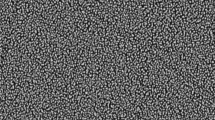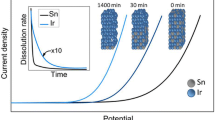Abstract
The effectiveness factor, E f, (fraction of the electrode surface that participates effectively in the investigated reaction) of fast (Fe3+/Fe2+), moderate (Cl2/Cl−) and slow (O2/H2O) redox couples has been estimated using IrO2-based electrodes with different loading. The method of choice was linear sweep voltammetry (measurement of the anodic peak current) for the Fe3+/Fe2+ redox couple and steady-state polarization (determination of the exchange current) for the O2 and Cl2 evolution reactions. The results have shown that the effectiveness factor depends strongly on the kinetics of the investigated redox reaction. For the Fe3+/Fe2+ redox couple, effectiveness factors close to zero (max 4%) have been obtained contrary to the O2 evolution reaction where effectiveness factors close to 100% can be achieved, all being independent of IrO2 loading. For the Cl2 evolution reaction, intermediate values of the effectiveness factor have been found and they decrease strongly, from 100% down to about 60%, with increasing loading.





Similar content being viewed by others
References
Levenspiel O (1972) Chemical reaction engineering, 2nd edn. Wiley Eastern Ltd, New Delhi, p 473
Coeuret F, Hutin D, Gaunand A (1976) J Appl Electrochem 6:417
Savinell RF, Zeller RL, Adams JA (1990) J Electrochem Soc 137:489
Shub DM, Reznik MF, Shalaginov VV (1985) Elektrokhimiya 21:937
Baticle AM, Perdu F, Vennereau P (1971) Electrochim Acta 16:901
De Faria LA, Boodts JFC, Trasatti S (1996) J Appl Electrochem 26:1195
Da Silva LM, Boodts JFC, De Faria LA (2001) Electrochim Acta 46:1369
Fierro S, Nagel T, Baltruschat H, Comninellis Ch (2007) Electrochem Comm 9:1969
Acknowledgement
The authors acknowledge the Fonds National Suisse de la Recherche Scientifique for the financial support.
Author information
Authors and Affiliations
Corresponding authors
Appendix: Analytical solution of the effectiveness factor
Appendix: Analytical solution of the effectiveness factor
Coeuret et al. [2] attributed the observed decrease of effectiveness with increasing electrode thickness to an overpotential distribution in the electrolyte within the coating. In order to determine the effectiveness of a DSA® electrode, we have adopted this approach proposed originally for the design of a porous medium for the recovery of heavy metals. As illustrated in Fig. 6, we consider a differential element of thickness, Δx, and cross-section, A g, and we suppose no concentration gradient in the pores.
Schematic representation of the DSA® electrode according to a spherical particle configuration (SPC) consisting of IrO2 spherical particles with diameter, d p, showing a differential element of thickness, Δx, and cross-section, A g. L is the thickness of the coating and X is the dimensionless distance. (a) Ti substrate; (b) electrolyte
Considering that the electronically conductive phase of the coating is equipotential, one can obtain for the overpotential, η, as a function of the dimensionless distance, X, the following second order linear ordinary differential equation:
whose solution is written as
The dimensionless number K 2 includes the morphological parameters like specific particle area, a p (cm−1), void fraction of the DSA® coating, porosity, ε (–), thickness of the coating, L (cm), the apparent electrolyte conductivity (γ) and the kinetics of the investigated electrochemical reaction (j 0). For spherical particles, the specific area, a p, is equal to 6/d p, where d p is the particle diameter (cm). The apparent electrolyte conductivity within the DSA® coating, γ, depends on the void fraction, ε, as follows [2]:
where γ is the apparent electrolyte conductivity inside the DSA® coating (Ω−1 cm−1), and γ0 is the bulk electrolyte conductivity (Ω−1 cm−1).
Using the low-field approximation of the Butler-Volmer relationship,
where j is the current density (A cm−2), j 0 is the exchange current density (A cm−2), F is the Faraday constant 96485 (C mol−1), R is the molar gas constant 8.31 (J mol−1 K−1), T is the temperature (K) and η is the overpotential (V), the parameter K is given by Eq. 16:
Finally, the effectiveness factor, E f, of the DSA® coating can be calculated from K with Eq. 17:
Rights and permissions
About this article
Cite this article
Calderon, E.H., Katsaounis, A., Wüthrich, R. et al. Effectiveness factor of fast (Fe3+/Fe2+), moderate (Cl2/Cl−) and slow (O2/H2O) redox couples using IrO2-based electrodes of different loading. J Appl Electrochem 39, 1827–1833 (2009). https://doi.org/10.1007/s10800-009-9886-2
Received:
Accepted:
Published:
Issue Date:
DOI: https://doi.org/10.1007/s10800-009-9886-2





